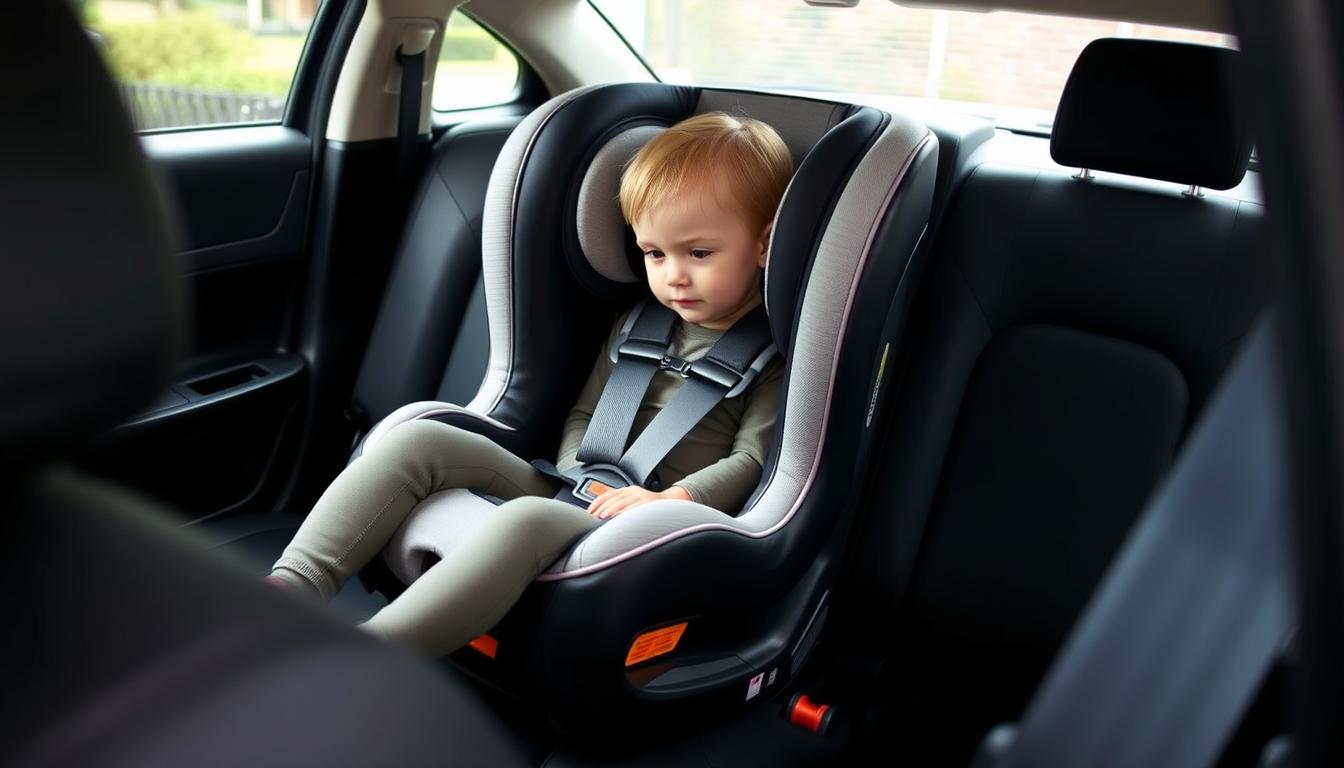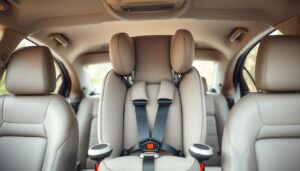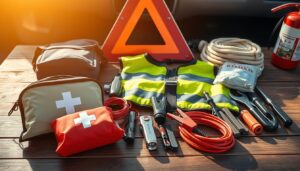Child Safety Tips for Cars
Every single day, motor vehicle crashes are a leading cause of injury for young passengers across the nation. This fact can feel overwhelming, but here’s the powerful truth: the correct use of safety seats and belts can dramatically reduce these risks.
Welcome, parents and caregivers! This guide is your friendly resource for protecting your most precious cargo on every journey. We’ll walk with you from the infant years all the way through the teenaged driving stage.
The right information is your best tool. This means choosing the perfect restraint for your kid’s age and size, installing it correctly, and avoiding common mistakes. We break it all down into simple, manageable steps.
True protection goes beyond the equipment itself. It’s also about smart driver behavior, preventing heatstroke, and minimizing distractions to create a culture of security for everyone on the road.
Bookmark this page. As your little one grows, their needs will change. We’ll provide expert advice and real-world solutions to help your family stay informed and secure at every stage.
Key Takeaways
- Properly used car seats and seat belts are highly effective at preventing serious injuries.
- This guide covers safety from infancy through the teenage years.
- Selecting the right restraint system for your kid’s age and size is the first critical step.
- Correct installation is just as important as having the right equipment.
- Safe travel involves driver habits and minimizing in-vehicle distractions.
- You can return to this resource as your children grow and their needs evolve.
Understanding Child Passenger Safety

Research provides powerful evidence that proper restraint systems save young lives on the road. The numbers speak volumes about their effectiveness in protecting our most vulnerable travelers.
Benefits of Correct Car Seat Use
Studies show remarkable results when families use appropriate safety equipment. Restraint systems reduce death risk by 71% for infants and 54% for toddlers during collisions.
Booster seats offer similar protection for older kids. They cut serious injury risk by 45% for children ages 4 to 8. These aren’t just statistics—they represent real lives protected.
Young passengers need special protection because their bodies are still developing. Proper restraints shield growing bones and organs during sudden impacts.
Key Safety Legislation and Guidelines
Every state recognizes the importance of this protection. All 50 states, plus Washington D.C. and Puerto Rico, have laws requiring proper restraint use.
While laws set minimum standards, families should aim higher. Keep kids in each restraint type as long as possible within manufacturer limits.
True protection means using the right seat correctly every trip. Consistent use builds lifelong safety habits that benefit everyone in the vehicle.
Child Safety Tips for Cars: Best Practices and Expert Advice
Leading safety organizations like Safe Kids Worldwide have identified seven critical areas that families should focus on to ensure maximum protection. This comprehensive approach goes beyond basic restraint use to address both in-vehicle and environmental hazards.
Protection involves understanding developmental stages and staying current with guidelines. Key areas include proper restraint selection, heatstroke prevention, and driveway awareness. Each element contributes to complete security for young passengers.
Expert guidance consistently emphasizes extended use of each restraint type. Current recommendations suggest keeping young ones in each stage longer than minimum legal requirements provide the best protection.
| Restraint Type | Minimum Requirement | Expert Recommendation | Key Benefit |
|---|---|---|---|
| Rear-Facing Seat | Age 2 or height limit | Until height/weight limits reached | Superior head/neck support |
| Forward-Facing Harness | Age 4 or 40 pounds | Until harness limits reached | Better impact distribution |
| Booster Seat | Age 8 or 4’9″ tall | Until proper belt fit achieved | Correct seat belt positioning |
Consistency matters tremendously for true protection. Using the right restraint correctly on every trip builds lifelong security habits. Adult modeling of good behavior reinforces these practices.
View vehicle security as an evolving practice that requires periodic reassessment. As young passengers grow and research advances, staying informed ensures ongoing protection during travel.
Choosing the Right Car Seat and Booster Seat for Your Child

Finding the perfect restraint system for your little one involves more than just checking age requirements. The right choice depends on three key factors working together.
Selecting by Age, Height, and Weight
Manufacturer guidelines provide specific limits for each restraint type. Always check both the maximum height and weight limits before making your selection.
Current recommendations emphasize keeping young passengers in each stage longer. This approach provides superior protection during sudden stops or impacts.
| Restraint Type | Minimum Age | Weight Range | Key Consideration |
|---|---|---|---|
| Rear-Facing | Birth to 2+ years | 4-50 pounds | Maximize within limits |
| Forward-Facing | 2-4+ years | 20-65 pounds | Use harness fully |
| Booster Seat | 4-12 years | 40-100+ pounds | Proper belt fit |
Rear-Facing vs. Forward-Facing Options
Modern convertible seats now accommodate most children rear-facing until at least age 3. Higher weight limits of 35-50 pounds make this possible.
As one expert notes,
“The rear-facing position provides the best protection for developing spines and necks during sudden impacts.”
When children reach the maximum limits for rear-facing, they transition to forward-facing seats with harnesses. These distribute crash forces across stronger body areas.
Booster seats become necessary when young passengers outgrow harnessed seats but aren’t tall enough for proper seat belt positioning. Most need boosters until they reach 4’9″ in height.
Proper Installation and CPST Assistance
A surprising number of restraint systems are installed incorrectly, creating hidden risks. Research shows about 90% have at least one error, with the average having three mistakes. This makes proper installation more challenging than many parents realize.
You have two main options for securing the seat in your vehicle. Both the standard lap and shoulder belt system and the LATCH (Lower Anchors and Tethers for Children) system provide equal protection when used correctly.
| Installation Method | Best For | Key Advantage | Important Note |
|---|---|---|---|
| Vehicle Seat Belt | All vehicles | Universal compatibility | Must lock properly |
| LATCH System | Vehicles 2003+ | Easier installation | Check weight limits |
Step-by-Step Installation Tips
Always begin by reading both the restraint manual and your vehicle’s manual. Position the seat in the back, preferably in the center when possible. Thread the belt or attach LATCH connectors according to instructions.
Make sure the installation is tight—the seat should move less than one inch at the belt path. For rear-facing positions, check the recline angle using the built-in indicator. Forward-facing installations always need the top tether connected.
Finding Certified Child Passenger Safety Technicians
Certified Child Passenger Safety Technicians (CPSTs) complete specialized training to help families. They can inspect your installation and answer specific questions about your seat and vehicle combination.
Locate these experts through local hospitals, fire stations, or online databases. Having a professional check your work provides peace of mind and catches errors even careful parents might miss.
Minimizing In-Car Distractions and Preventing Heatstroke
Two often-overlooked aspects of travel security can have devastating consequences when not properly addressed. Maintaining driver focus and preventing heat-related dangers are essential for complete protection.
Avoiding Mobile Distractions on the Road
Using phones while driving creates significant risks. Talking increases crash likelihood by 2-4 times. Texting multiplies this danger by 8 times.
The real issue involves mental focus, not just hand placement. Even hands-free conversations pull attention away from driving. This slows reaction time and makes accidents more likely.
| Distraction Type | Crash Risk Increase | Primary Danger | Recommended Action |
|---|---|---|---|
| Hands-Free Calling | 2-4 times | Mental distraction | Silence phone while driving |
| Hand-Held Calling | 2-4 times | Physical & mental distraction | Use “Do Not Disturb” feature |
| Texting | 8 times | Visual & mental distraction | Pull over if necessary |
Implementing Effective Heatstroke Prevention Methods
Leaving young passengers in vehicles poses extreme dangers. Their bodies overheat five times faster than adults. This can happen even on cloudy days or with windows open.
Always check back seats before locking your car. Make this part of your routine every time you park. Use memory aids like moving a stuffed animal to the front seat when your little one is riding.
Keep important items in the back to force checking. Contact childcare providers if routines change. These habits help ensure everyone stays protected from temperature risks.
Ensuring Consistent Seat Belt Usage and Safety
The simple click of a seat belt represents one of the most powerful protective actions we can take during travel. This habit protects everyone in the vehicle, creating a shared environment of security.
When someone rides without proper restraint, they become what experts call “human missiles” during sudden stops. Research shows that even properly buckled passengers face three times greater risk when others aren’t secured.
Buckle-Up Best Practices for All Vehicle Occupants
Proper seat belt fit is essential for maximum protection. The lap portion should rest snugly across the upper thighs, not the stomach. The shoulder belt needs to cross the center of the chest and shoulder.
Young passengers often need a booster seat to achieve this correct positioning. The five-step test helps determine readiness for transition. Can they sit against the seat back with knees bent comfortably? Does the lap belt fit properly across the thighs?
Most young ones need booster assistance until they reach about 4’9″ tall. The back seat remains the safest position for those under 13 years old. This keeps them away from front airbags that could cause injury.
Adults play a crucial role by modeling consistent seat belt behavior. When young passengers see caregivers buckling up every trip, they’re more likely to develop this lifelong habit. Pregnant women should also wear seat belts properly positioned below the belly.
Make buckling up an automatic, non-negotiable part of every car journey. This simple practice creates a culture of security that benefits all vehicle occupants.
Additional Safety Measures for Safe Road Travel
When families hit the road for vacations or use transportation services, maintaining proper restraint practices becomes crucial. Protection doesn’t take holidays, and consistent habits ensure security during all journeys.
Travel, Taxi, and On-the-Go Safety Tips
Travel-friendly restraint systems make vacation security manageable. Lightweight options designed for easy installation work well in rental vehicles and airplanes.
Taxi and rideshare situations require planning. Some cities offer services with appropriate seats, or families can bring portable options. Always ensure proper restraint use during these trips.
| Travel Scenario | Recommended Approach | Key Consideration | Safety Benefit |
|---|---|---|---|
| Airplane Travel | Use FAA-approved restraint | Check airline policies | Consistent protection |
| Rental Vehicle | Bring travel-friendly seat | Verify compatibility | Familiar equipment |
| Taxi Service | Use portable booster seat | Quick installation | Immediate security |
| Relative’s Car | Transfer proper seat | Correct installation | Continuous safety |
Registering restraint systems with manufacturers provides important updates. Companies notify owners about recalls or safety notices affecting their specific model.
Most collisions occur during routine trips near home. Using the correct seat every time provides essential protection. Create habits that prioritize security during all travels.
Vehicle security extends beyond driving moments. Keep cars locked when parked and store keys safely. Teach young ones that vehicles aren’t play spaces to prevent accidents.
Always check around your vehicle before moving. Establish waiting zones away from cars during loading. These practices prevent tragic incidents involving unseen little ones.
Conclusion
The road to protecting your family begins with the commitment to apply these principles consistently. From selecting the right restraint to proper installation, each step builds a foundation of security.
Remember that this responsibility evolves as young ones grow. What works for infants changes as they become toddlers and school-age children. Regular checks ensure seats fit properly and installations remain secure.
Statistics clearly show that proper restraint use dramatically reduces injury risks. Sharing this information with caregivers maintains consistent standards across all vehicles.
While it may seem complex, taking it step-by-step makes it manageable. Your consistent efforts create lifelong habits that keep everyone protected through all the years of travel.
FAQ
At what age can my kid move to a booster seat?
How can I tell if my car seat is installed correctly?
What is the safest spot in the vehicle for a car seat?
What should I do if my child unbuckles their seat belt while driving?
Are there special tips for using car seats in taxis or ride-shares?
How can I prevent heatstroke in my vehicle?

Adam Peter is a finance, travel, and automotive writer with over a decade of experience. He creates clear, practical content to help readers manage their money, explore the world with confidence, and make informed decisions about cars and travel gear. His work blends expert insight with real-world usefulness.




